When I got my first bass 15 years ago, all I wanted to do was play fast metal grooves immediately.
Needless to say, it didn`t go too well at first. My technique was sloppy, my tone sounded awful, and I developed painful blisters in record time.
Thankfully, I`ve learned a thing or two since then about what it means to be a metal bassist. Because of this, I have written this article to show you some of the things I`ve learned along the way. My goal with this is to make your journey as a metal bassist easier than mine was.
I`ll cover whether it is difficult to play metal bass, and gives some useful tips on how to approach the genre. Then, I`ll show you how to set your tone, and what scales lend themselves best for metal.
Lastly, I`ll cover how to write metal basslines, and leave you with some exercises that are tailored specifically for playing metal bass.
Is it hard to play metal bass?
In general, the bass guitar is easy to pick up and hard to master. This holds especially true as a metal bassist. A big reason for this is that metal basslines differ from very easy, to extremely difficult and that it is demanding to write advanced basslines that fit well within metal songs.
There are many easy metal bass lines, that beginners can play adequately after a short matter of time. These tend to consist of straightforward 8th note grooves or long sustained notes. Thus, getting started as a metal bassist is significantly easier than as a violinist or pianist.
On the other hand, some of the best metal bass lines are very demanding to play. Most of them are played at fast tempos and have a lot of melodic movement in them. Thus, they are demanding on both your right and left hand, and require a level of control and precision that takes years to develop.
Another thing that makes metal bass easy to pick up, but hard to master is tone. Finding a basic metal tone that works for the genre is not overly difficult. However, knowing all of your tonal options and developing an understanding of how to use them takes a lot of experience.
Thus, playing metal bass has a lower barrier of entry than most instruments. At the same time, it is a genre where the best of the best have pushed the instrument to its limit in sub-genres like tech-death and progressive metal. With that, it is also incredibly difficult to master the instrument at a high level.

How do you get a metal tone bass?
While playstyle, instrument choice, and set up all affect your tone, there are two things that are particularly important when playing metal on a bass.
These are your amp settings and whether you use a distortion pedal.
Amp settings
Amp settings and EQ for metal bassists, can be tricky. This is because a tone that sounds good when playing on your own, might not work well when playing with a band, and vice versa.
In a band, you also need your tone to be sharp enough to be heard among distorted guitars and deep enough to hold down the low-end. While achieving either of the two is easy, achieving both at the same time is significantly more demanding.
To best achieve this, here are my recommended basic settings for solo play, and when playing with a band:
EQ for playing metal bass alone:
- Bass: 7
- Low-Mids: 6
- High-Mids: 5
- Treble: 5
EQ for playing metal with a band:
- Bass: 4
- Low-Mids: 6
- High-Mids: 6
- Treble: 5
This will give you enough low-end to sound heavy while retaining some sharpness when playing on your own. As you don`t need the mid and high-frequencies to cut through the mix, you can put a bigger emphasis on the lows for a heavier tone.
In a band, too much low-end can quickly muddy down the sound of the band. Furthermore, the mid and high-frequencies in your tone won`t be distinguishable enough among the other instruments and result in the bass being hard to hear.
Thus, it is preferable to turn down the lows a bit and put more emphasis on the mids.
The above settings are a good place to start. However, developing a good metal tone that fits your personal style can only be achieved through trial and error. Thus, it is beneficial to know what the settings on your bass amp do, and experiement with these to see how changing them impacts your tone.
Distortion
Distortion is not a necessity for a great metal tone. Among others, Martin Mendez of Opeth doesn`t rely on distortion to play groovy and fitting basslines.
However, distortion is a helpful tool that can enhance your tone and make it more fitting for the genre.
A common misunderstanding about distortion for metal bass players is to think of it as binary. Either you don`t use distortion, or you use a lot of it.
On the contrary, I`ve personally had the best success by using moderate and slight amounts of distortion. This has enabled me to get a growlier tone that sounded heavier, without drenching it in distortion and clashing with the guitars.
If you don`t currently own a distortion pedal, my recommendation is the AZOR Distortion. This is because it has different settings that are specifically designed to fit different genres of metal.
Thus, this pedal is great for aspiring metal bassists, as you can make use of it in everything from classic heavy metal to modern metalcore.
Metal bass scales
Out of all the metal bass scales that are used in the genre, there are two that are absolutely essential to know. There are the minor scale and the chromatic scale, and the vast majority of metal music is written in either of the two.
The minor scale
The great thing about scales is that once you memorize their pattern, you can play that scale in any key. As an example, here is what the A minor scale looks like when played on the bass guitar.
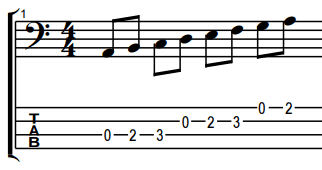

If you play every note one fret higher up, you get the A# minor scale. One step further and you have the B minor scale, and so forth. Thus, I recommend practicing this pattern until you know it like the back of your hand. As a metal bassist, you will be using it often.
For melodic riffs in minor keys, it`s common for bassists to repeat the root note. Examples of this can be heard in Judas Priest`s Breaking The Law and Amorphis` House Of Sleep.
Another common technique is to play the root note of the scale using an open string while playing a melody. For examples of this listen to Crawl Through Knives by In Flames, and Fuel by Metallica.
The scale has also been used to great effect by progressive metal bands who like to combine heavy and tranquil elements. Oftentimes, bass players in these bands play groovy and melodic lines. For examples of this, listen to Martin Mendez`s work in Opeth, and Thomas MacLean/Conner Green`s basslines in Haken.
Lastly, here are also some well-known metal songs that make use of the minor scale:
| Metal Band: | Notable minor scale songs: |
| Metallica | Nothing Else Matters, The Unforgiven |
| Dio | Holy Diver, Rainbow In The Dark |
| Black Sabbath | Paranoid, Heaven And Hell |
| Iron Maiden | The Trooper, Aces High |
| Rammstein | Du Hast, Ich Will |
| Judas Priest | Breaking The Law, The Rage |
The chromatic scale
The second essential scale for metal bassists is the chromatic scale. It differs from diatonic scales, as instead of consisting of 7 notes, it is made up of 12. In other words, the scale makes use of every single note:
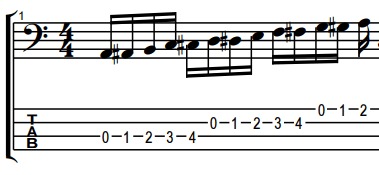

Because of this, the chromatic scale does not have the same type of harmonic foundation as the minor scale.
Therefore, it can also be used to make music that sounds sinister as it breaks the common rules of harmony. In turn, the scale lends itself very well to metal and has played a major part in shaping the sound of the genre.
Most commonly, the chromatic scale is used to play riffs that are centered around playing an open string. From there, the riffs incorporate other notes from the chromatic scale to add melody and groove.
Examples of this can be heard on Master Of Puppets By Metallica and Rain By Trivium.
While the chromatic scale consists of every note, one note in particular plays a key role in metal riffs: The tritone.
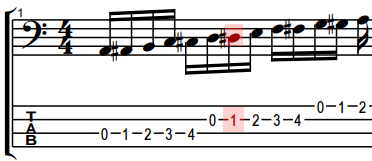
In Diatonic scales, the tritone is rarely a part of the scale. This is because it is a disharmonic note that just sounds plain evil. However, metal riffs tend to make great use of it for this exact reason.
For examples of the tritone being used in metal bass riffs, listen to Into The Void by Black Sabbath and War Ensemble by Slayer.
Lastly, here’s a list of some well-known metal songs that are played in the chromatic scale:
| Metal Band: | Notable chromatic scale songs: |
| Metallica | Master Of Puppets, For Whom The Bell Tolls |
| Megadeth | Holy Wars… The Punishment Due, Tornado Of Souls |
| Lamb Of God | Laid To Rest, Redneck |
| Mastodon | Blood And Thunder, Megalodon |
| Disturbed | Stricken, The Animal |
| In Flames | Take This Life, Touch Of Red |

How to write metal basslines
In metal, it is common for the bass to double the rhythm guitar. This works incredibly well, as it creates a wall of sound which is a big part of how metal bands are able to sound heavy. Metal basslines occasionally take on a more melodic role, when there is enough space to do so in a mix.
Even the most technical and creative of bassists often double the guitar for the sake of holding the song together. Thus, the best way for beginners to write metal bass lines is generally to play the same riff as the rhythm guitarist is playing.
You might however find yourself playing with just one guitarist, or that you are the one who needs to write the rhythm part. For this scenario, here are some common ways to write fitting metal bass lines:
- Straight 8th notes: Kingdom Come by Manowar, Shut Your Mouth by Pain
- Straight 16th notes: Sulfur by Slipknot (Verse), Inside The Fire by Disturbed (Pre-Chorus)
- Galloping rhythm: Run To The Hills by Iron Maiden, Headless Cross by Black Sabbath
- Staccato single notes: Vacuity by Gojira, Ghost Divison by Sabaton
- Sustained whole notes: Reise, Reise by Rammstein, In Your Face by Children Of Bodom (Chorus)
- Combing 8th and 16th notes: Trigger by In Flames (Verse), In Waves by Trivium
- Short bursts of notes followed by a rest: Endzeit by Heaven Shall Burn (Verse), Death Unlimited by Norther
Using these methods, and experimenting with combing them will have you off to a good start.
Metal bassists who deviate from doubling the rhythm guitar often do so by writing melodic basslines instead. This is incredibly challenging, as they still need to fill in the low-end frequencies, and avoid clashing with the guitars.
They are generally able to achieve this in one of two ways. One is to pick their spots and to add melody to a song when there is space for it. Another is for the band to make space for the bass guitar so that it can be played as a lead instrument.
The best thing to do for getting a feel for this is to listen to metal bassists who are able to do either of the two well. Here`s a list of some of the best bassists that have done so, and what it is that makes them stand out:
| Bass Player: | Band: | Reason for standing out: |
| Cliff Burton | Metallica (1982-1986) | Playing the bass as a lead instrument. Heavy use of distortion. Incorporated harmonics and chords. |
| Jeroen Thesseling | Obscura | Technical and fast. Melodic playstyle that deviates from the guitars. Plays unconventional rhythms. Incorporates chords and slides in creative ways. |
| Justin Chancellor | Tool | Lots of unique tones that are tailored to fit individual songs. Uses delay to add depth to songs. Plays the main riff on songs without the guitar doubling it. |
| Ryan Martinie | Mudvayne, Soften the Glare | Combines slapping and playing melodies for a unique style. Uses slides, chords, and tapping to add flavor to his bass lines. |
| Steve Harris | Iron Maiden | Plays melodic bass lines without songs sounding hollow. |
| Peter Steele | Type O Negative (1989-2010) | Melodic playstyle. Used the bass as a lead instrument. Made his basslines interesting by making use of bends and chords. |
| Fieldy | Korn | Unique slapping style and bass tone. Plays the bass like a percussive instrument. |
Metal bass exercises
While general bass exercises will be helpful for playing metal, there are some areas of your technique that are worth paying extra attention to as a metal bassist.
In particular, it is beneficial to focus on finger dexterity and developing your plucking speed.
Finger dexterity
For finger dexterity, I started using an exercise a couple of years ago that is aimed specifically at playing metal riffs. It is a variation of playing a scale up and down, which is a common way to practice and warm up.
However, instead of just ascending and descending a scale, it reverts back to the tonic after every note. This lets you familiarize yourself with the scale and build dexterity, but in a way that is more resemblant to how metal riffs are actually played.
Start with the exercise below, which is played in the key of A minor. Play it at a tempo you feel comfortable with, and rather too slow than too fast. When you master it, you can increase the speed and try playing different scales.
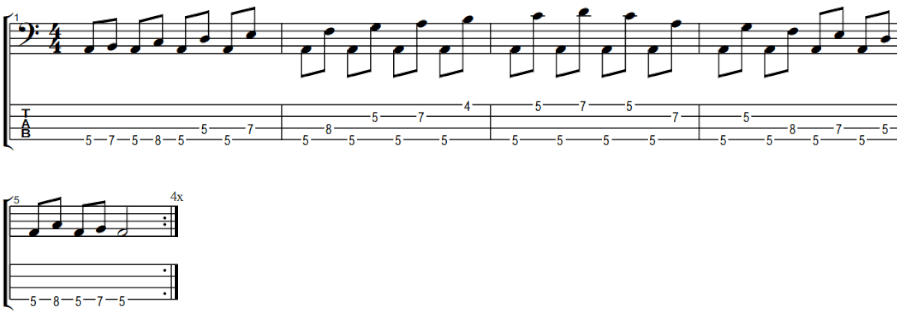
Plucking Speed
As for building plucking speed, this is achieved by starting slow, mastering playing at this tempo, and gradually increasing the speed.
A mistake I did when I started out was that I always tried to push boundaries and play as fast as I could. While this seemed intuitive to do, it ultimately slowed down my progress and resulted in me having to fix my technique and build up speed again later on.
Thus, start with a slow tempo around 70 BPM, and play open string 8th notes.
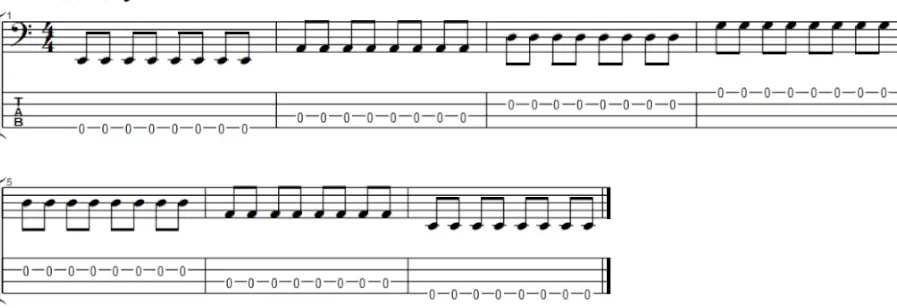
This lets you dial in your technique, practice playing with control, and damping unplayed strings.
When you can play sets of 8 notes at a time with control, play them in sets of four.

And when that feels natural, play them in pairs.

Then when you get the hang of that, increase the tempo. At slow speeds, you can increase the tempo by 5 BPM at a time. At higher speeds, it will be more appropriate to increase the tempo by 1 or 2 BPM at a time.
This method lets you develop the control and technique needed to play at faster speeds from the ground up. From experience, I can tell you that despite how counterintuitive playing slow feels for developing speed, this method works extremely well.
Answering common questions
There are 4 questions that I see metalheads who are looking to pick up the bass or have just done so commonly run into. Thus, here`s a brief answer to all of them:
Can I play metal on a jazz bass?
A jazz bass lends itself well to playing metal. Among others, Troy Sanders of Mastodon, Ian Hill of Judas Priest, and Martin Mendez of Opeth have all played the instrument.
This is in large part because jazz basses have vast tonal options which can make the instrument equally fitting for metalcore and progressive metal.
However, this also requires the bassist to use the tonal controls of the jazz bass to their advantage. Thus, it can take some trial and error to get the type of metal tone you want out of the instrument.
Can I play metal on a Precision bass?
Precision basses have been used to play metal. Some metal bassists play the instrument intermittently, and bassists like Steve Harris of Iron Maiden and Chi Cheng of Deftones have played it as their main instrument.
The P bass has a fat tone that works well for heavy genres like rock and metal. It is however limited in its tonal options and can feel limiting to bassists who like customizing their tone to fit the song.
While the tone of the P bass will fit some bands perfectly, it can thus lead to a mismatch in others. Especially so if you are looking for a modern metal tone.
Do I need to tune down my bass to play metal?
Tuning down is not a requirement to play metal. Bands like Metallica, Megadeth, and Black Sabbath`s biggest songs are in E standard, and it is a tried and true tuning in the genre.
Alternate bass tunings such as Drop D are however commonly used in the metal. Thus, if you join a band, or are looking to cover songs, tuning down can quickly become a necessity.
Therefore, it is beneficial to have a basic understanding of what tuning down a bass entails as a metal bassist.
Do you need 5 string bass for metal?
You do not need a 5-string bass to play metal. 4-string basses can be tuned down to have the same deep range as 5-string basses with a setup and string change.
5-strings can however make it more convenient to play in lower tunings. They are tuned to B standard, which gives you enough range to play in most common alternate tunings.
There are also some metal songs that are written on the 5-string and use the full range of the instrument. Songs of this kind can generally be arranged for the 4-string as well, but can on occasion make them harder to play.
Conclusion
To this day, metal has been the most fulfilling and fun genre I`ve has the pleasure of playing.
This is because there are so many satisfying this about playing bass in a metal band. Setting the perfect tone for a song, and finding spots to incorporate melodic licks will never get old. Most importantly, the rush of headbanging when playing live is one of the best feelings on earth.
Thus, my hope is that the above information provides you with a good starting point on your own musical journey.
Learning the basics and focusing on improving at the right things from the very beginning is extremely helpful. I can tell you this from experience, cause that`s not what I did.
Thus, the above information will save you a lot of headache down the line, if you put what you have learned to good use. Best of luck.

